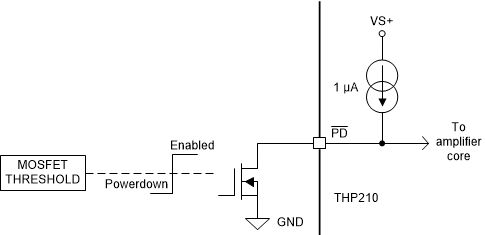SBOS932C January 2020 – March 2021 THP210
PRODUCTION DATA
- 1 Features
- 2 Applications
- 3 Description
- 4 Revision History
- 5 Pin Configuration and Functions
- 6 Specifications
- 7 Parameter Measurement Information
- 8 Detailed Description
-
9 Application and Implementation
- 9.1 Application Information
- 9.2 Typical Applications
- 10Power Supply Recommendations
- 11Layout
- 12Device and Documentation Support
- 13Mechanical, Packaging, and Orderable Information
Package Options
Mechanical Data (Package|Pins)
Thermal pad, mechanical data (Package|Pins)
Orderable Information
9.1.5 Operating the Power-Down Feature
The power-down feature on the THP210 puts the device into a low power-consumption state, with quiescent current minimized. To force the device into the low-power state, drive the PD pin lower than the power-down threshold voltage (VVS+ – 2 V). Driving the PD pin lower than the power-down threshold voltage forces the internal logic to disable both the differential and common-mode amplifiers. The PD pin has an internal pullup current that allows the pin to be used in an open-drain MOSFET configuration without an additional pullup resistor, as seen in Figure 9-7. In this configuration, the logic level can be referenced to the MOSFET, and the voltage at the PD pin is level-shifted to account for use with high supply voltages. Be sure to select an N-type MOSFET with a maximum BVDSS greater than the total supply voltage.
 Figure 9-7 Power-Down (
PD) Pin Interface With Low-Voltage Logic Level Signals
Figure 9-7 Power-Down (
PD) Pin Interface With Low-Voltage Logic Level SignalsFor applications that do not use the power-down feature, tie the PD pin to the positive supply voltage.
When PD is low (device is in power down) the output pins is in a high-impedance state.